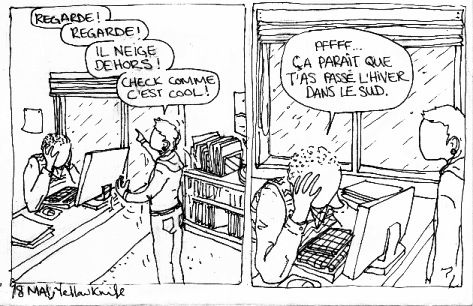What government & other agencies do if Canadian #Arctic waters are threatened by a spill
http://ow.ly/1RxZh
An official Indian Affairs and Northern Development #PDF document
Published under the authority of the Minister of Indian Affairs and Northern Development Ottawa, 2003
QS-Y215-000-EFHIII-A-A1 Catalogue No. R2-266/2003 ISBN 0-662-67571-1
© Minister of Public Works and Government Services Canada
[excerpt]
WORKING TOGETHER
WHAT GOVERNMENT AND OTHER AGENCIES DO IF CANADIAN ARCTIC WATERS ARE THREATENED BY A SPILL
UN TRAVAIL D'ÉQUIPE
COMMENT LE GOUVERNEMENT ET LES DIVERS ORGANISMES RÉAGISSENT LORSQU'IL Y A DANGER DE DÉVERSEMENT DANS LES EAUX TERRITORIALES CANADIENNES DE L'ARCTIQUE
INTRODUCTION
Government departments, along with various boards and agencies, are responsible for regulating the development of natural resources in the North in a way that does the least harm to the environment and to northerners' quality of life. Companies are once again interested in exploring for oil and gas in the Arctic. This booklet explains the role of agencies in responding to spills of harmful substances in Canadian Arctic waters.
BACKGROUND
In the late 1980s, the Government of Canada, along with the governments of the Yukon and the Northwest Territories (which then included Nunavut), issued a Strategy for Major Pollution Incidents in the Arctic Seas Regions which described how agencies and people would work together if there was a major spill in Arctic offshore waters. Today, the agencies responsible for responding to spills continue to plan together and to conduct joint response exercises.
PLANS AND WORKING AGREEMENTS
The northern agencies that work together to ensure spills are handled properly are the Canadian Coast Guard, the National Energy Board and the Department of Indian Affairs and Northern Development. Each agency has plans that describe how it will respond to a number of different situations. It is important that these plans take an integrated approach to avoid duplication or overlap, and to ensure that everyone works together when a spill occurs. The names of these plans, and contact information for the three agencies, appear in Appendix 1 (page 6).
Canada has also made a commitment to circumpolar environmental protection and is actively involved in the international efforts of the Arctic Council to prevent pollution and respond to spills into the Arctic Ocean.
The Northwest Territories/Nunavut Spills Working Agreement provides for a 24-hour spill reporting system, and a clearly understood division of responsibilities relating to the investigation and monitoring of spills in the two territories. (The Yukon has a similar arrangement.) This arrangement also provides for a system to disseminate information. The agreement designates a lead agency, depending on the specific legal and program responsibilities of the various agencies, their expertise, and the source of the spill. The division of responsibility for spills affecting Arctic waters is outlined below.
SPILL SOURCE
Spills from ships and barges
Spills from oil and gas exploration and production facilities
Spills from facilities/operations licensed under DIAND legislation
LEAD AGENCY
Canadian Coast Guard
National Energy Board
Department of Indian Affairs and Northern Development
For a spill into Arctic waters, the lead agency may call upon other agencies to provide assistance. Resource agencies can be approached directly for help on specific issues. For example, Environment Canada may help with weather forecasts and information on ice conditions, or Fisheries and Oceans may provide information on the location and possible impact on important fish and marine mammal species, such as beluga whale populations.
Environment Canada may also activate the Arctic Regional Environmental Emergencies Team (REET). The Arctic REET is an interagency committee that includes representatives from federal, territorial and Aboriginal organizations with environmental expertise. It is chaired by a representative of Environment Canada. The purpose of the REET is to provide consolidated environmental advice to the lead agency. The objective of the REET is to minimize damage to sensitive resources and habitats, while making the best use of limited response resources. The Arctic REET Contingency Plan describes the organizational framework, purpose, functions and composition of the team; the notification and activation procedures; and the classification and escalation of response to environmental emergencies. Contact information for
all Arctic REET agencies, their respective team members and their alternates is attached to the plan. Resource agencies may provide essential services such as transportation, accommodation and communications.
Information, Communications and Media Specialist
Spécialiste en l'information, communications et media
451 Norseman Dr.
Yellowknife, Northwest Territories
X1A 2J1, Canada
Yellowknife Land Line # (867) 873-2662
Yellowknife Cell # (867) 445-9193
E-mail: mediamentorATgmailDOTcom
Website
Twitter Feed on Northern & First Nations Issues
Twitter Feed on Journalism & Media Issues
Member:
Canadian Association of Journalists
Canadian Artists Representation / le Front des artistes canadiens
Canadian Artists Representation Copyright Collective






 Now Liz and Barb have teamed up to write
Now Liz and Barb have teamed up to write 

